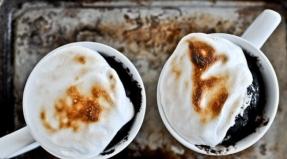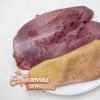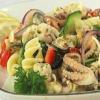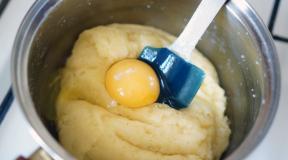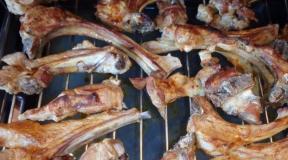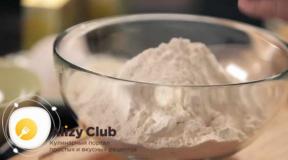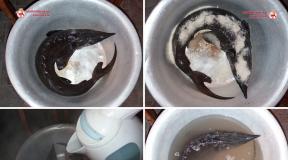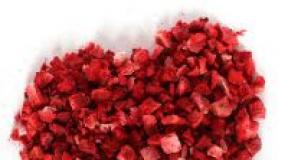Technology for the preparation of fermented milk products. Technological process of production of fermented milk products
MINISTRY OF YOUTH EDUCATION AND SPORTS
TECHNICAL UNIVERSITY OF MOLDOVA
Department of Technology and Public Catering
Course work
According to the technology of milk processing on the topic:
"Technology of liquid fermented milk products and drinks"
Performed:
Student gr. TL-052
Checked:
Senior Lecturer Popescu L.
Chisinau 2009
Introduction
1. Assortment of liquid fermented milk products.
Terms and definitions…………………………………..3
2. Finished product quality indicators………….5
3. General technology………………………………………….8
4. Theoretical foundations of production………………10
5. The influence of various factors on the production process..14
6. Vices……………………………………………………… 17
Bibliography.
Introduction
national sour milk product is a fermented milk product that has a historically established name in the country, depending on the type of starter culture and specific technology.
Dairy products include liquid dairy products and drinks, as well as cottage cheese and curd products and sour cream. Liquid fermented milk products and drinks include the following products.
1. Assortment of liquid fermented milk products .
curdled milk - a national fermented milk product made by fermenting milk with pure cultures of lactococci and / or thermophilic lactic streptococci, the total content of which in the finished product at the end of the shelf life is at least 107 CFU per 1 g of the product, without the addition of non-dairy components.
Mechnikovskaya prostitute - a national fermented milk product made by fermenting milk with pure cultures of thermophilic lactic acid streptococci and lactic acid bulgarian sticks, the total content of which in the finished product at the end of the shelf life is at least 107 CFU per 1 g of the product, without the addition of non-dairy components.
Ryazhenka - a national fermented milk product made by fermenting baked milk with pure cultures of thermophilic lactic streptococci, the total content of which in the finished product at the end of the shelf life is at least 107 CFU per 1 g of the product, without the addition of non-dairy components.
Varenets - a national fermented milk product made by fermenting milk sterilized or heat treated at a temperature of (97 ± 2) ° C for 40 to 80 minutes with pure cultures of thermophilic lactic streptococci, the total content of which in the finished product at the end of the shelf life is at least 107 CFU in 1 g of the product, without the addition of non-dairy components.
Kefir - a national fermented milk product of mixed lactic and alcoholic fermentation, made by fermenting milk with sourdough prepared on kefir fungi without adding pure cultures of lactic acid bacteria and yeast, content lactic acid microorganisms in the finished product at the end of the expiration date is at least 107 CFU per 1 g of product, and yeast is at least 104 CFU per 1 g of product, without the addition of non-dairy components.
acidophilus - a national fermented milk product made by fermenting milk with pure cultures of lactic acidophilus bacillus, lactococci and sourdough prepared on kefir fungi in equal proportions, the total content of lactic acid microorganisms in the finished product at the end of the shelf life is at least 107 CFU per 1 g of the product, without the addition of non-dairy components.
Airan - a national fermented milk product of mixed lactic and alcoholic fermentation, made by fermenting milk with pure cultures of thermophilic lactic acid streptococci, lactic acid bulgarian bacillus and yeast, the content of lactic acid microorganisms in the finished product at the end of the shelf life is at least 107 CFU per 1 g of the product, and yeast is at least 104 CFU per 1 g of the product, without the addition of non-dairy components.
Kumys - national fermented milk product of mixed lactic and alcoholic fermentation, produced by fermentation mare's milk pure cultures of Bulgarian and acidophilic lactobacilli and yeast, the content of lactic acid microorganisms in the finished product at the end of the shelf life is at least 107 CFU per 1 g of the product, and yeast is at least 105 CFU per 1 g of the product, without the addition of non-dairy components.
Yogurt - a fermented milk product with a high content of skimmed milk solids, produced by fermenting with a protosymbiotic mixture of pure cultures of thermophilic lactic acid streptococci and lactic acid bulgarian sticks, the content of which in the finished product at the end of the shelf life is at least 10 7 CFU per 1 g of the product (it is allowed to add food additives, fruits, vegetables and products of their processing).
1.1. Classification of liquid fermented milk products and drinks
Fermented milk drinks, depending on the milk raw materials from which they are produced, are divided into products :
From natural milk;
From normalized milk;
From reconstituted milk;
From recombined milk;
from their mixtures.
Sour-milk drinks, depending on the mass fraction of fat, are divided into products :
Fat-free (m.d.zh.,%, 0.1);
Non-fat (m. d. w.,%, 0.3; 0.5; 1.0);
Low-fat (m.d. w.,%, 1.2; 1.5; 2.0; 2.5);
Classical (m. d. w.,% 2.7; 3.0; 3.2; 3.5; 4.0; 4.5);
Fat (m. f.,%, 4.7; 5.0; 5.5; 6.0; 6.5; 7.0);
High-fat (m. f.,%, 7.2; 7.5; 8.0; 8.5; 9.0; 9.5).
2. Indicators of the quality of the finished product .
According to organoleptic indicators, fermented milk drinks must meet the requirements indicated in Table 1
Table 1
Organoleptic indicators fermented milk drinks
By physical and chemical indicators fermented milk drinks Must meet the requirements specified in Table. 2
table 2
Physico-chemical indicators of fermented milk products
Phosphatase is not allowed in the product.
Table 3
| Indicators | Permissible levels, mg/kg (l), no more |
| Toxic elements: | |
| lead | 0,1 |
| arsenic | 0,05 |
| cadmium | 0,03 |
| Mercury | 0,005 |
| Mycotoxins: | |
| aflatoxin M, | 0,0005 |
| Antibiotics: | |
| chloramphenicol | not allowed |
| tetracycline group | not allowed |
| streptomycin | not allowed |
| penicillin | not allowed |
| Pesticides: | |
| hexachlorocyclohexane (a, P, y-isomers) | 0,05 |
| DDT and its metabolites | 0,05 |
| Radionuclides: | |
| cesium-137 | 100 |
| strontium-90 | 25 |
Microbiological indicators of fermented milk drinks are shown in table. 4
Table 4
Microbiological indicators of fermented milk drinks
Product name |
Quantity lactic acid microorganisms, cfu/g, no more |
Product mass (g, cm3), in which are not allowed |
Yeast, molds, CFU/g, no more |
||
| BGKP (coliforms) | Pathogenic incl. salmonella | S. aureus | |||
| Liquid fermented milk products, wt. h. yogurt with a shelf life of no more than 72 hours | - | 0,01 | 25 | 0,1 | - |
| Liquid fermented milk products, including yogurt with a shelf life of more than 72 hours | not less than 1 * 10 7 (not standardized for heat-treated products) | 0,1 | 25 | 1,0 | yeast - 50 (except for drinks made using starter cultures containing yeast), molds - 50 |
| Liquid fermented milk products enriched with bifidobacteria with a shelf life of more than 72 hours | not less than 1*10 7 ; bifidus bacteria - not less than 1 * 10 6 |
0,1 | 25 | 1,0 | yeast - 50 (except for drinks made using starter cultures containing yeast), molds - 50 |
| Ryazhenka | - | 1,0 | 25 | 1,0 | __ |
For the manufacture of fermented milk drinks, the following raw materials are used :
raw cow's milk not lower than the second grade according to GOST E52054; whole milk powder premium according to GOST 4495; skimmed milk powder according to GOST 10970; cream powder according to GOST 1349; unsalted butter according to GOST 37; starter cultures based on pure cultures of lactic acid microorganisms produced according to TU 9229-369-0019785-04 “Start cultures, bacterial concentrates, yeast and test cultures”; drinking water according to SanPiN 2.1.4.1074 (for recombined or reconstituted milk).
3.General technology of fermented milk products .
Milk and other raw materials are accepted according to the weight and quality established by the quality control department (laboratory) of the enterprise, as well as on the basis of certification documents of supplier firms.
Immediately after taking the milk
1. warm up to a temperature of 35 ... 40 ° C and cleaned on centrifugal milk cleaners or other equipment without heating. For the cleaning raw milk it is also recommended to use a bacteriophage with a specially built hermetic separator to remove bacteria from milk.
2. After this milk is sent for processing or cooled to a temperature of (4 ± 2) °C and stored in intermediate storage tanks. Storage of milk, cooled to a temperature of 4 °C, before processing should not exceed 12 hours, cooled to a temperature of 6 °C-6 hours.
3. Selected quality milk normalize by mass fractions of fat and protein in such a way that they in the finished product are not less than those provided by the standard.
Normalization, as well as the preparation of butter, the restoration of dry dairy products is carried out in such a way as was shown in the technology of drinking milk.
4. normalized mixture warm up to a temperature of (43 ± 2) °С and cleaned on centrifugal milk cleaners or filters.
5. Purified milk homogenize at a pressure of (15.0 ± 2.5) MPa at a temperature of 45 to 85 °C. If necessary, it is allowed to homogenize milk at the pasteurization temperature.
Instead of complete homogenization, it is allowed to use separate homogenization of milk. When using separate homogenization, milk normalized for fat and heated in the second regeneration section of the plate pasteurizer to a temperature of 55 ... 65 ° C is separated. Wherein mass fraction fat in the resulting cream is from 16 to 20%. The resulting cream is homogenized in a two-stage homogenizer at a pressure: in the first stage from 8 to 10 MPa, in the second - from 2 to 2.5 MPa. The homogenized cream in the stream is mixed with the skimmed milk leaving the cream separator and sent to the pasteurization section.
In order to improve the taste of fermented milk drinks, it is also recommended to homogenize the milk intended for their production with a fat mass fraction of less than 2.5%.
6. Purified and homogenized mixture pasteurized at a temperature of (92 ± 2) °C with an exposure of 2 to 8 minutes or (87 ± 2) °C with an exposure of 10 to 15 minutes. Milk can be kept at these temperatures for 30 to 40 minutes. In the production of ryazhenka, milk is pasteurized at temperatures from 95 to 99 ° C with an exposure of 3 to 4 hours until a pronounced light cream color, and Varentsa - at the same temperatures with an exposure of 60 to 80 minutes.
In the production of ryazhenka, it is necessary to take into account the degree of bacterial contamination, composition, thermal stability of raw materials, etc. It is allowed to pre-pasteurize the normalized mixture at a temperature of (76 ± 2) ° C, followed by heating to a temperature of 95 ... 99 ° C with holding from 3 to 4 hours to a pronounced light cream color. Moreover, during heating, the mixture is stirred 1-2 times per hour to prevent the formation of foam.
7. After pasteurization and aging milk chilled to fermentation temperature : (40 ± 2) °С or (30 ± 2) °С in the production of curdled milk; (42 ± 2) °С in the production of Mechnikovskaya curdled milk, yogurt, fermented baked milk, Varenets, etc.; (37 ±2) °С in the production of acidophilic fermented milk drinks; from 18 to 25 ° C in the production of kefir, etc., that is, to a temperature that is optimal for the development of microflora used in the production of a particular fermented milk drink. Storage of the unfermented mixture at the fermentation temperature is not allowed.
With the tank method of production, milk is fermented and fermented in tanks for fermented milk drinks with a cooling jacket, equipped with special agitators that ensure uniform and thorough mixing of milk with ferment and fermented milk clot. To avoid foaming, which affects the separation of whey during the storage of fermented milk drinks, milk is fed into the tank through the lower fitting.
The starter is prepared in accordance with the current technological instructions for the preparation and use of starters and bacterial concentrates for fermented milk products at dairy industry enterprises, approved in the prescribed manner.
The starter is introduced into milk in a stream using a dosing pump simultaneously with milk, or after some time from the start of filling the tank, or after filling the tank. The volume fraction of the starter in relation to the volume of the fermented mixture prepared with sterilized or pasteurized milk is 3...5%. During the introduction of the starter, the milk must be stirred to evenly distribute the starter in the volume of the product and prevent the formation of protein flakes. Milk with added starter is stirred for 10 ... 15 minutes.
With the tank method of production, after mixing, the fermented milk is left alone for fermentation. It is allowed to re-mix in 1...1.5 hours after fermentation.
At thermostatic method In production, milk is fermented in tanks for fermented milk drinks with a cooling jacket, equipped with special agitators that ensure uniform and thorough mixing of milk with ferment. Fermented milk is immediately poured into consumer containers with continuous stirring. Filling from each tank must be completed within 45-60 minutes to avoid the formation of coagulated protein flakes. The mixture is fermented in a thermostatic chamber at the temperature indicated below.
The temperature and duration of fermentation in the production of fermented milk drinks is different depending on the microflora of the used starter. The modes are the same in the production of the same type of fermented milk drink by tank or thermostatic production methods. The end of fermentation is determined by the nature of the clot and its acidity. The clot should be smooth, sufficiently dense and not secrete serum. Temperature and duration of fermentation:
In the production of curdled milk - for 5 to 7 hours at a temperature of (30 ± 2) °С and from 3 to 4 hours at a temperature of (40 ± 2) °С
when using dry bacterial concentrate of lactococci, milk is fermented at a temperature of (30 ± 2) °С from 8 to 10 hours, when using dry bacterial concentrate of thermophilic lactococcus - at a temperature of (40 ± 2) °С from 6 to 8 hours; I in the production of fermented baked milk, yogurt, Mechnikov yogurt, varenets, etc. - for 4 to 6 hours at a temperature of (40 ± 2) ° C or when using dry bacterial concentrate - for 8 ... 10 hours at a temperature ( 40 ± 2) °С;
in the production of acidophilic fermented milk drinks - for 7...9 hours at a temperature of (37 ± 2) °C;
in the production of kefir - for 8 to 12 hours at a temperature of 18 to 25 °C. In addition, in the production of kefir, the fermented mixture is matured for 9 to 13 hours at a temperature of (14 ± 2) °C.
Fermented mixtures are fermented until a milk-protein clot and acidity are formed: from 75 to 80 °T in the production of curdled milk; from 65 to 70 °T - in the production of fermented baked milk; from 85 to 100 tons - in the production of kefir, etc.
8. At the end of fermentation in the reservoir method of production, the supply is turned on ice water temperature (2 ± 2) °С into the interstitial space of the tank for partial cooling of the clot to a temperature: in the production of curdled milk - 25 ... 35 °С, in the production of fermented baked milk - (22 ± 5) °С; in the production of kefir - (14 ± 2) ° С
In the tank method of production, after a period of 60 to 90 minutes after water supply, the mixer is turned on and the curd is stirred for 10 to 30 minutes, depending on the design of the mixer and the viscosity of the curd, to obtain a homogeneous consistency of the curd. When storing fermented milk drinks with a heterogeneous, lumpy consistency, whey may be released. Further mixing, if necessary, is carried out periodically, including the stirrer for 5 ... 15 minutes.
In the production of kefir, the milk clot mixed and cooled to a temperature of (14 ± 2) ° C is left alone for maturation for a period of 9 to 13 hours. It is allowed to send a mixed and partially cooled clot for bottling, followed by maturation and cooling of the packaged kefir in a refrigerator. From the moment of fermentation to the end of ripening, at least 24 hours must pass.
2 to 5 minutes - in the production of kefir or within 5 to 15 minutes - in the production of fermented baked milk and curdled milk.
When mixing, pumping and pouring a fermented milk clot, it is recommended to avoid intense mechanical impact (long narrow pipelines, pumps, leading to significant damage to the clot, etc.), air suction, which negatively affects the quality of the finished product. It is desirable to pour the fermented clot by gravity with a minimum level difference in height.
Stirred coagulum with a pump designed to viscous liquids, served for bottling in consumer packaging. In the presence of plate coolers, the clot can be cooled to a temperature of (4 ± 2) °C before bottling.
9. The packaging and labeling of fermented milk drinks is carried out in accordance with the requirements of the current standard for this product. The duration of bottling the fermented product from one container should not exceed 2 hours.
The packaged fermented milk drink, if necessary, is additionally cooled in a refrigerator to a temperature of (4 ± 2) °C, after which the technological process is considered complete and the product is ready for sale.
With a thermostatic method of production, after fermentation, the packaged product is placed in refrigerator compartment and cooled to a temperature of (4 ± 2) °C. In the case of the production of kefir in the refrigerator for 8 ... 13 hours, the milk-protein clot matures. After that, the technological process is considered complete and the product is ready for sale.
4. Theoretical foundations of production
The production of fermented milk products is a complex biochemical process, as a result of which the taste and smell, texture and appearance peculiar only to this fermented milk product are formed. Fermented milk products are obtained by fermenting heat-treated milk, cream, buttermilk, whey, or mixtures thereof.
According to GOST 51917, a fermented milk product is a dairy product made by fermenting milk or cream with kefir fungi and / or pure cultures of lactic acid, propionic acid, acetic acid microorganisms and / or yeast and / or mixtures thereof. The total content of lactic acid microorganisms in the finished product at the end of the shelf life is not less than 107 CFU per 1 g of the product. After fermentation, the use of food additives, fruits, vegetables and products of their processing is allowed. Bifidoproduct is a product containing bifidobacteria, the amount of which at the end of the expiration date is not less than 106 CFU per 1 g of the product.
The technological process for obtaining fermented milk products includes the following general operations:
- normalization of milk raw materials by fat, in the production of kefir - additionally by protein, yogurt - by mass fraction of milk solids;
- heat treatment,
- homogenization
- fermentation and fermentation,
- cooling
- packaging.
In the production of fermented milk products, both biochemical and physico-chemical processes are carried out
- milk sugar fermentation,
- casein coagulation
- gelation.
BIOCHEMICAL AND PHYSICO-CHEMICAL PROCESSES IN THE PRODUCTION OF FERROUS DAIRY PRODUCTS
Dairy products play important role in the nutrition of people, especially children, the elderly and the sick. The dietary properties of fermented milk products are primarily that they improve metabolism, stimulate the secretion of gastric juice and stimulate appetite. The presence in their composition of microorganisms that can take root in the intestine and suppress the putrefactive microflora leads to inhibition of putrefactive processes and the cessation of the formation poisonous products protein breakdown entering the human blood
FERMENTATION OF MILK SUGAR
The most important biochemical process that occurs during the production of fermented milk products is fermentation milk sugar caused by microorganisms of bacterial starter cultures. Its speed and direction determine the texture, taste and smell. finished products According to the nature of the fermentation of milk sugar, fermented milk products can be divided into two groups. The first group includes products based on the preparation of which is mainly lactic fermentation (yogurt, yogurt, acidophilus, cottage cheese, sour cream), the second group - products with mixed fermentation, in the manufacture of which lactic and alcoholic fermentation occurs (kefir, koumiss, acidophilus - yeast milk).
During lactic acid fermentation, each pyruvic acid molecule formed from a glucose molecule is reduced with the participation of the redox enzyme lactate dehydrogen-1 to lactic acid:
By increasing the acidity of milk during lactic acid fermentation, you can calculate how much milk sugar was fermented. For example, the acidity of milk increased by 60T (acidity of fresh milk was 17°T, after fermentation of milk sugar - 77T). 1˚T corresponds to I cm3 0.1 n. alkali solution or 1 cm30.1 n. lactic acid solution, which is 90 / (10 1000) \u003d 0.009 g of lactic acid. Therefore, 60T will correspond to 600.009 - 0.54 g of lactic acid.
From the total reaction lactic acid fermentation it follows that 4 moles of lactic acid are formed from 1 mole of milk sugar, i.e., 4-90 = 360 g of lactic acid is formed from 342 g of milk sugar. Therefore, to obtain 0.54 g of lactic acid, milk sugar was required
Many lactic acid bacteria during the fermentation of sugar, in addition to lactic acid, form a number of other chemical substances, which give fermented milk products a specific taste and aroma. These include volatile acids (acetic, propionic, etc.), carbonyl compounds (diacetyl, acetoin, acetaldehyde), alcohol and carbon dioxide.
Depending on the products accumulated during the fermentation process, all lactic acid bacteria are divided into homofermentative and heterofermentative. Lactic acid bacteria (lac. lactis, Lac. cremoris, Lac. diacetilactis, Str. thermophilus, L. bulgaricus, L. acidophilus), which form lactic acid as the main fermentation product, are classified as homo-enzymatic; bacteria (Leuc. cremoris, Leuc. dextranicum, etc.), which, in addition to lactic acid, form other fermentation products in significant quantities, are heterofermentative.
By certain combination various kinds lactic acid bacteria and regulation of the fermentation temperature, you can get a product with the desired taste, aroma, texture and dietary properties.
 In fermented milk products with mixed fermentation (kefir, koumiss, etc.), along with lactic acid, a large number of ethyl alcohol and carbon dioxide. The causative agent of alcoholic fermentation in these products is yeast. During alcoholic fermentation, pyruvic acid, under the action of the enzyme pyruvate decarboxylase, which catalyzes the elimination of carbon dioxide, is split into acetaldehyde and carbon dioxide:
In fermented milk products with mixed fermentation (kefir, koumiss, etc.), along with lactic acid, a large number of ethyl alcohol and carbon dioxide. The causative agent of alcoholic fermentation in these products is yeast. During alcoholic fermentation, pyruvic acid, under the action of the enzyme pyruvate decarboxylase, which catalyzes the elimination of carbon dioxide, is split into acetaldehyde and carbon dioxide:
Acetic aldehyde with the participation of the redox enzyme alcohol dehydrogenase is reduced to ethanol:
The ability of yeast to produce alcohol and carbon dioxide depends on many factors: the type of yeast used, the amount of milk sugar in the feedstock, temperature, pH, etc.
COAGULATION OF CASEIN AND GEL FORMATION
The accumulation of lactic acid during lactic acid fermentation of lactose is essential for the formation of a protein clot that determines the consistency of fermented milk products. The essence of acid coagulation is as follows. The resulting (or added) lactic acid reduces the negative charge of casein micelles, since H-ions inhibit the dissociation of casein carboxyl groups, as well as phosphoric acid hydroxyl groups. As a result, this achieves equality of positive and negative charges and the isoelectric point of casein (pH 4.6-4.7).
With acid coagulation, in addition to reducing the negative charge of casein, the structure of the caseinate-calcium phosphate complex is disturbed (calcium phosphate and structure-forming calcium are split off). Since calcium and calcium phosphate are important structural elements of the complex, their transition into solution additionally destabilizes casein micelles.
In the production of cottage cheese by the acid-rennet method, lactic acid and the introduced rennet are jointly acting on casein.
Under the influence rennet casein is converted to paracasein, which has an isoelectric point in a less acidic environment (pH 5-5.2).
At the isoelectric point, casein or para-casein particles aggregate upon collision, forming chains or threads, and then a spatial grid, into the cells or loops of which the dispersion medium with fat globules and other components of milk is captured. gelation occurs. In the production of fermented milk products and cheese, the gelation process can be divided into four stages: the stage of latent coagulation (induction period), the stage of mass coagulation, the stage of structure formation (clot compaction) and the stage of syneresis.
In colloidal systems, gelation is affected by the concentration of the dispersed phase, size, shape of particles, temperature, etc. The resulting clot (gel) has certain mechanical properties: viscosity, plasticity, elasticity and strength. These properties are associated with the structure of the system, so they are called structural-mechanical or rheological.
 Structural and mechanical properties of clots are determined by the nature of the bonds that arise between protein particles during the formation of the structure. Relationships can be reversible or irreversible. Reversible (thixotropic-reversible) bonds are restored after disruption of the clot structure. They cause the phenomenon of thixotropy (Fig. 1a) ((Greek thixis - touch + trope - change) - the ability of structures after their destruction as a result of some mechanical action to spontaneously recover in time.
Structural and mechanical properties of clots are determined by the nature of the bonds that arise between protein particles during the formation of the structure. Relationships can be reversible or irreversible. Reversible (thixotropic-reversible) bonds are restored after disruption of the clot structure. They cause the phenomenon of thixotropy (Fig. 1a) ((Greek thixis - touch + trope - change) - the ability of structures after their destruction as a result of some mechanical action to spontaneously recover in time.
Irreversible (irreversibly destroyed) bonds do not have the ability to recover after mechanical action on the clot. They are associated with the phenomenon of syneresis. Syneresis (Fig. 1b) - compaction, contraction of the clot with shortening of the casein threads and displacement of the liquid enclosed between them. Figure 2. The speed of syneresis is determined by the water-holding capacity of casein and depends on the concentration of dry substances in the raw material, the composition of bacterial starter cultures, the modes of heat treatment of homogenization, the method of milk coagulation and other factors.
For fermented milk drinks and sour cream, syneresis is an undesirable phenomenon. Therefore, bacterial starter cultures are used in their production. desired composition and the technological process is carried out under conditions that prevent the occurrence of syneresis. In the production of cottage cheese, on the contrary, it is required to remove excess whey from the clot. Therefore, such milk processing modes are chosen that would contribute to obtaining a dense, but easily releasing whey clot. To enhance syneresis, grinding, heating of the clot, etc. are also used.
The nature of the bonds in the structure of the clot (product) can be determined by measuring the so-called effective viscosity - the viscosity due to the formation of internal structures in the product. At the same time, the effective viscosity of the undestroyed η n, destroyed ηr and restored ηp structures is determined and compared with each other (Table 5)
As can be seen from Table 5, during the formation of clots of curdled milk and fermented milk drinks, irreversibly collapsing (non-thixotropic bonds) are mainly formed. There are few thixotropic bonds characterized by spontaneous recovery after mechanical action. Sour cream is characterized by a lower loss of viscosity during the destruction of the structure and large quantity thixotropic bonds compared to fermented milk drinks.
Table 5
 |
BIOCHEMICAL BASES OF PRODUCTION CERTAIN TYPES OF FERROUS MILK PRODUCTS
The quality of fermented milk products produced depends on the nature of the formed clots, as well as the degree of accumulation of flavoring and aromatic substances. The nature of the clots is determined by the level of accumulation of lactic acid, the ability of proteins to form spatial structures, retain moisture, etc. The formation of flavoring and aromatic substances depends on the composition of bacterial starter cultures, the conditions of fermentation, maturation and cooling of products.
fermented milk drinks
The main process that determines the consistency of all fermented milk drinks is gelation. The clots of these products are different: in some cases, the clot is dense (prickly), in others it is even and tender (creamy) or flaky, etc.
During the formation of the structure of product clots, irreversibly breaking bonds are mainly formed, there are few thixotropic-reversible bonds in them, therefore it is so important to conduct the technological process under such conditions that would ensure minimal separation from the whey clot. First of all, this applies to the modes of pasteurization, homogenization and fermentation of milk.
It is known that the syneretic properties of clots depend on the pasteurization temperature of milk. To increase the strength of clots and prevent the release of whey during storage of curdled milk and other fermented milk drinks, it is recommended to use high temperatures for pasteurization of milk (85-87°C with exposure for 5-10 minutes or 90-94°C with exposure for 2-8 minutes).
The duration of fermentation of milk during the development of products is determined by the type of bacterial starter and the fermentation temperature. The end of fermentation is usually set to obtain a sufficiently strong clot and titratable acidity of 75-85°T. In the production of fermented milk drinks by the tank method, it is necessary to obtain a clot with the maximum number thixotropically reversible bonds, therefore, before mixing and cooling the clot, the pH should be controlled: it should be 4.5-4.4 for kefir, 4.7-4.55 for acidophilus, 4.45-4 for ryazhenka, 35. Additionally, the viscosity of the clot is checked by the duration of the flow from a pipette with a capacity of 100 cm 3 at 20 ° C or using a capillary viscometer.
Specific sour-milk taste and smell of products are formed mainly during their fermentation and maturation. Complementing the taste and smell of products are compounds formed during the heat treatment of milk (they play a major role in the production of Varenets and fermented baked milk).
The main flavoring and aromatic substances of fermented milk products are milk and acetic acid, diacetyl, acetaldehyde (its high concentration is typical for yogurt), etc. Refreshing, slightly spicy taste koumiss and kefir are given ethyl alcohol and carbon dioxide. The alcohol retention in beverages is determined by the type of yeast, temperature and length of maturation. In koumiss, it is 1 - H "6, in kefir - 0.01-0.03%. They are also characterized by protein breakdown (proteolysis), so the released amino acids and peptides can take part in shaping the taste of these products.
5 . INFLUENCE OF MILK COMPOSITION, BACTERIAL STARTERS AND OTHER FACTORS ON FERTILIZATION LACTOSE AND CASEIN COAGULATION
The quality of fermented milk products, mainly their consistency, depends on the composition and properties of milk, the type and activity of bacterial starters, the modes of pasteurization, homogenization, fermentation, maturation, and other factors.
- Composition and properties of feedstock
determine the rate of coagulation of milk proteins and the strength of the resulting clots. The development of microorganisms of bacterial starter cultures that ferment milk sugar also depends on them.
The composition and properties of milk change throughout the year, the stage of lactation, in case of diseases of animals, etc. It is known from the practice of dairy plants that in autumn and especially in spring, milk is slowly fermented. This may be due to a decrease in its biological value. For example, in spring, the content of vitamins (biotin, niacin, B6, etc.), free amino acids (valine, leucine, phenylalanine, etc.) and microelements (Mn, Co, Fe, etc.), which are necessary for the reproduction of lactic acid bacteria, decrease in milk. bacteria. In addition, the reason for non-fermentation of milk at this time of the year may be the presence of antibiotics and other substances in it that inhibit the development of lactic acid bacteria. Lactic acid bacteria develop poorly in old milk and in milk obtained from cows with mastitis.
In the spring, the technological properties of milk also deteriorate - the rate of formation and density of the acid clot decrease. This is due to a decrease in the content of dry substances in milk, casein, the size of casein micelles, and an increase in the acidity of milk.
· Individual characteristics and breeds of animals
The ability of milk to rennet coagulation is determined by the concentration of proteins, calcium salts and depends on the individual characteristics and breed of animals, feed, stage of lactation and other factors. Milk coagulates poorly at the beginning and end of lactation, as well as when animals are sick.
· Storage time
The properties of milk (and the properties of the clot obtained from it) change during storage. Yes, after long-term storage milk (raw and pasteurized) low temperatures the viscosity and strength of the acid clot increase, syneresis slows down. Therefore, milk stored at low temperatures should be sent to the production of fermented milk drinks and should not be used. for making curd
· Starter composition.
Not only the taste of fermented milk products, but also their consistency depends on the composition of the starter cultures. The main component of the microflora of starter cultures of all fermented milk products, which ensures the formation of a clot, is lactococcus (Lac. lactis). The inclusion of energetic acid-forming agents in the composition of starter cultures results in a dense prickly clot with intensive separation of whey, and low-energy acid-forming agents - a more delicate clot. Introduction of sourdough Str. thermophilus, Lac. cremoris and thermophilic sticks increases the viscosity of the product, gives the clot elastic properties, prevents the release of whey.
Therefore, by selecting the composition of starter cultures, it is possible to regulate the properties of the clot and ensure the optimal consistency and taste of fermented milk products.
· Heat treatment
Heat treatment of milk affects the rate of clot formation, structural and mechanical properties and syneresis.
According to VNIMI and VNIIMS, with an increase in pasteurization temperature, the strength of acid and acid-rennet clots increases (Table 6).
Table 6

With an increase in the pasteurization temperature of milk (from 63 to 90" C ) the intensity of serum separation from the clot decreases high temperatures heat treatment can be explained by an increase in the content of denatured whey proteins in the clot, which increase the rigidity of the spatial structure and the water-holding capacity of casein.
Thus, by adjusting the modes of heat treatment of milk, it is possible to obtain a clot with the desired rheological properties, i.e., improve the consistency of the fermented milk product
· Milk homogenization
When producing fermented milk drinks, it is recommended to homogenize milk before fermentation (for kefir and yogurt obtained by the tank method, it is mandatory). As a result of homogenization, the dispersion of fat increases, the crushed fat in clots is distributed more evenly, the strength of the clot increases, while the viscosity of the products slightly increases and whey release decreases.
At the same time, homogenization of milk with a high (above 10%) fat content and cream contributes to a significant increase in the viscosity of clots and a decrease in their ability to separate whey. In this case, the increase in the viscosity of the formed clots depends on the pressure and the method of homogenization of the raw material.
Structural-mechanical and syneretic properties of clots significantly depend on the method of protein coagulation
 |
· Type of coagulation
Clots formed during acid coagulation of proteins are less strong than acid-rennet ones (the spatial structure of acid clots is supported by weak bonds, the structure of acid-rennet ones is additionally stabilized and strengthened by calcium bridges formed between the parts of paracasein); they consist of smaller protein particles and secrete serum worse. However, along with an increase in the strength of acid-rennet clots, their fragility, the degree of dispersion and the ability to separate whey during processing increase.
· Clotting time and temperature
The duration and temperature of curdling (fermentation) of milk are important factors affecting the consistency of fermented milk products. The duration of milk fermentation is usually determined by the increase in acidity, viscosity or strength of the resulting clot. It is especially important to determine the moment of clot readiness in the production of beverages by the tank method. Sometimes observed liquid consistency products and whey sludge. This is caused by the wrong choice of the moment of clot mixing. Whey is released when the clot is stirred when it has a minimum viscosity and exhibits slight thixotropic properties.
In addition, the accumulation in the products of substances that give them a certain taste and aroma (volatile acids, diacetyl, acetaldehyde, etc.) depends on the temperature and duration of milk fermentation.
To stop lactic acid fermentation and strengthen the structure of the formed clot, fermented milk products are cooled to 8°C and stored at this temperature. Products of mixed fermentation before cooling are subjected to maturation, for the development of yeast and aroma-forming bacteria. In the process of maturation and aging in the refrigerator, aromatic substances, alcohol and carbon dioxide accumulate in the products, and there is also a partial breakdown of proteins under the influence of proteolytic enzymes of lactic acid bacteria and yeast. At the same time, various soluble polypeptides and free amino acids are formed, which affect the texture, taste and smell of products.
In the production of sour cream, an additional purpose of cooling and ripening is the solidification of fat, which helps to improve the structure and consistency of the product.
5. FAULTS OF FERROUS MILK PRODUCTS .
Bibliography
1 TO. K. Gorbatova "BIOCHEMISTRY OF MILK AND DAIRY PRODUCTS" St. Petersburg GIORD 2004
2.N. A. Tikhomirova "Technology and organization of production of milk and dairy products" 2007 Moscow DeLi print
Fermented milk products are produced in two ways: thermostatic and reservoir.
Scheme: milk acceptance - normalization - pasteurization - cooling - 1 (reservoir) fermentation in the tank - fermentation - cooling - maturation - packaging - storage - sale. 2 (thermostatic) fermentation in a thermostat and bottling in consumer packaging - fermentation in a thermostatic chamber - cooling in a refrigerator - maturation - storage - sale.
Acceptance and evaluation of milk: the mass fraction of fat, density, acidity, temperature, organoleptic indicators. Raw materials are used: at least 2 grades with an acidity of less than 20 degrees T, a reductase test of at least 1 class, fur. pollution not more than 1 group, density not lower than 1.027g/cm3. Skimmed milk: acidity less than 20°T, density not less than 1.030g/cm3
Milk purification: carried out at 43°C. Homogenization: at R-15MPa, 45-48 degrees C. Pasteurization: 85-87 degrees C - 10-15 minutes, 92 degrees C - 2-8 minutes. Cooling? to fermentation temperature. Fermentation: sourdough 3-5% of the total volume, mixing 15 min. Fermentation: 10-12 hours, the end of fermentation is determined by acidity (65-90 degT) and clot density. Cooling: with ice water with stirring (30-60 min), until a homogeneous mass is obtained. Adding fillers: add fillers to a partially cooled clot, mix, serve for bottling. Storage: no more than 36 hours at 6 degrees C from the end of those. percent
Technology for the preparation of liquid fermented milk products.
Fermented milk drinks TU 46.073-2003
Developed by the National Association of Dairymen of Ukraine. It applies to sour-milk drinks that are fermented with a special starter with or without sugar, stabilizers, milk powder, natural fruit fillers, with further heat treatment.
Assortment: drink "Jubilee" (1, 2.5%); drink "Jubilee" with fruit filling (1, 2.5%); drink "Snowball" (1.0, 2.5, 3.2, 3.5%); drink "Snowball fruit and berry" (1%); low-fat yogurt (1.5, 2.5, 3.2, 3.5%); fruit and berry yogurt (1, 3.5%).
Organoleptic indicators. Appearance and consistency: homogeneous, moderately viscous. With the reservoir method - with a broken clot; at thermostatic - with undisturbed. With the presence of soft particles of fruits and berries, whey separation is allowed no more than 2-3%. The drink "Snowball" has a slight flouriness.
Taste and smell. Pure fermented milk, moderately sweet, with a taste and smell of the added filler.
Color. Depends on the filler or milky white.
Acidity. Anniversary - 80-110 degrees T (pH - 4.6-4.0); "Snowball" - 80-120 degrees T (pH - 4.6-3.9); yogurt - 80-140 degrees T (pH - 4.4-3.8)
Sucrose is added more than 7%, jam - more than 4%.
Microbiological indicators. Bacteria of the Escherichia coli group are not allowed in 0.1 g of the product. Salmonella is not allowed in 25 g of the product. Staphylococcus aureus is not allowed in 0.1 g of the product. The number of lactic acid microorganisms is not less than 1 million per cm3.
Storage. At a temperature of 4+-2gardS. If the product is without stabilizers and leaking, no more than 36 hours. Without stabilizers, but in sealed packaging - no more than 3 days. With a stabilizer and in sealed packaging up to 14 days.
This is a fermented milk drink obtained by fermenting milk with sourdough on kefir fungi.
Range: low fat, 1%, 2.5%, 3.2%.
Acidity 850120grad.
Appearance and texture. Homogeneous, with a broken clot in the tank method of production and undisturbed in the thermostatic method. Gas formation is allowed, in the form of separate bubbles.
Taste and smell. Pure fermented milk, refreshing, slightly spicy.
A slight separation of whey is allowed - no more than 2%. Microbiological indicators. Bacteria of the Escherichia coli group - not allowed in 0.01 g prod. Pathogenic microorganisms are not allowed in 1 g of the product.
Shelf life, as in dairy products.
Scheme of directions for processing milk into kefir.
Milk 3.4% - normalized mixture - (sourdough 5%): 1 - kefir 1%; 2 - kefir 2.5%; 3 - kefir 3.2%.
A fermented milk drink made from baked milk fermented with pure cultures of thermophilic lactic streptococci, with or without the addition of Bulgarian sticks.
Range: 1%, 2.5%, 4%.
Acidity 70-110grad.
Appearance and texture. Homogeneous, the presence of foam is allowed.
Taste and smell. Clean, fermented milk, with a pronounced aftertaste of pasteurization.
Color. Light cream, due to the presence of melonoidins, due to the languor of milk.
Technological features. Pasteurization temperature - 95-98 degrees C with an exposure of 3-5 hours, in order to obtain a light-cream color and a specific taste.
Storage. In the presence of stabilizers no more than 14 days.
The requirement for raw materials is the heat resistance of milk.
Yogurt.
A fermented milk product produced from milk by fermenting it with pure cultures of lactic acid bacteria.
Ordinary yogurt.
Cooked only in a thermostatic way. The sourdough contains thermophilic lactic acid streptococcus and Bulgarian stick. The starter temperature is 40°C. The duration of fermentation is 3-4 hours. A dense clot is formed without gas formation. Taste and smell - pure sour milk. Color - milky white. Acidity 80-130grad. Storage: at a temperature not higher than 8 degrees C - 36 hours.
Southern curd.
thermostatic method. The sourdough is the same and + lactic yeast. Fermentation 6-8 hours. Color - milky white. Taste - pure sour-milk, alcoholic aftertaste. The clot is dense. In the presence of mucous strains, there may be a viscous consistency. Acidity - 90-140 degrees T.
Acidophilic yogurt.
Sourdough - acidophilus bacillus, lactic acid streptococcus. The taste is sour milk. The consistency is tender, in the presence of mucous strains - viscous. Acidity - up to 140grad
Taste and smell: pure sour milk, with a pronounced taste and aroma of pasteurized cream (during pasteurization of cream, diaceyl, acetoin is formed). All types of sour cream are allowed to have a slightly fodder aftertaste (especially in the winter-spring period), and a slight bitterness.
Color: white with a cream shade.
Physical and chemical indicators.
Acidity: 10.15.30% - 60-90grad; 20.25% - 60-100 degrees T. Phosphatase is absent. The temperature of release from the factory is less than 6 degrees C. For sour cream produced using dry dairy products, an increase in the upper limit of acidity by 10 degrees T is allowed.
Microbiological indicators.
Bacteria of the Escherichia coli group are not allowed in 0.001 g of the product. Pathogenic microorganisms are not allowed in 25 g of the product. Staphylococcus aureus is not allowed in 1 g of the product.
Scheme of milk processing directions for sour cream.
Milk 3.4% (for separation) - : 1 - skimmed milk residue; 2 - cream (for normalization) -: 1 - sour cream 10%; 2 = (adding fillers) dessert sour cream.
At present, more than 300 species are produced. All of them are produced by fermenting raw materials with pure bacterial starters. Under certain conditions, the microflora turns into so-called. secondary microflora. It gives the products a specific taste and smell. Use: Mesophilic streptococci, thermophilic streptococci and coli, yeast. Their use in various combinations makes it possible to obtain a large amount of sour mol. products.
In the production of fermented milk products, milk is used, in which the protein content is not less than 3%, lactose is not less than 4.5%. In addition, in the production of cottage cheese by the rennet method, the rennet coagulability of milk is determined, it should be 1 or 2 classes. Production of sour milk. products is carried out in 2 ways. 1) reservoir 2) thermostatic. The tank method uses large production areas, but it is a relatively cheap method. The thermostatic method requires additional, equipment costs, but requires less manufacturing. areas. Scheme of the production of fermented milk products by the thermostatic method.
Acceptance and quality assessment of raw materials, reservation, heating and cleaning, normalization by fat, pasteurization, cooling to 1 fermentation (for mesof. 30-32°C, for thermofil. 40-42°C, for kefir fungus 20 °C), packaging , introduction of starter (in each container), hermetic sealing, fermentation and maturation in a thermostatic chamber, cooling (up to t 6-8), storage and sale. (72 hours) The shelf life of sour cream is 5 days. Cottage cheese is produced in 2 ways: Traditional and separate. In addition, depending on the method of fermentation of milk, cottage cheese is produced: Acid method (only sourdough is added) Rennet method (in addition to sourdough, rennet and calcium chloride are added). Defects of fermented milk products: Defects of taste and smell. Excessively sour taste and smell. Violated modes of fermentation and fermentation, as well as transportation and storage. Feed taste and smell. Mild taste and smell. Due to the violation of the technological regimes of fermentation. Rancid taste and smell. For high fat foods. Color defects: uneven. Consistency defects: heterogeneous with whey separation - violation of transportation and storage regimes.
55. Butter production technology.
For production butter milk of at least grade 2, cream of grade 1 or 2 is used. Cream of the 1st grade is not allowed to have mechanical impurities, protein flakes, traces of freezing. The temperature of incoming cream of grade 1 should not be higher than 10°C, grade 2 should not exceed 15°C. It is most preferable to use raw materials with a high fat content.
The production of butter is carried out in 2 ways: 1) Churning; 2) Conversion of high fat cream
Technological scheme for the production of butter by the churning method. Acceptance and quality assessment of raw materials, cooling (up to 14-6°С), reservation, heating (30-35°С), cleaning, separation (receiving cream (32-35% fat), heat treatment of cream (pasteurization), physical maturation cream (low-temperature processing), cream churning, butter grain processing, buttermilk separation, butter washing, butter mechanical treatment, packaging, storage and sale.
Cleaning, separation is carried out: in separators of open or closed type. The fat content of the resulting cream depends on the type of butter produced.
Heat treatment is carried out in order to destroy all harmful microflora, as well as inactivate enzymes that accelerate oil deterioration. Pasteurization below 85 °C is not carried out. For cream I grade I pasteurized in summer 85-90, in winter 92-95. For butter produced from cream of the 2nd grade t, regardless of the time of year 95, with preliminarily. Cream deodorization. Cream must go through a stage of physical maturation. When churning cream that has not passed this stage, a soft product with a smearing consistency with a large waste of fat into buttermilk is obtained.
Cream churning is carried out in continuous or batch butter makers. The temperature at which the cream is churned depends on the time of year, the fat content of the cream and the degree of solidification of the fat in the cream. For summer it is 7-12°C, winter 8-14. The churning process can be divided into 3 stages: I) Beginning of churning (the viewing window of the churn is covered with a film of cream). 2) The formation of individual oil grains (the window brightens 3) Finish, the formation of oil grains (the window is transparent and oil grains are visible). The duration of churning of a periodic butter churn is 20-30 minutes. Butter grains separated from buttermilk are washed 2 times with drinking water, t which is 2 ° C lower than the churning t, to remove lactose, protein residues from butter grains, min. substances. The volume of wash water is 50% of the initial volume of cream. The washed grain is pressed and molded. To do this, the churn is transferred to the deboning mode, lasting 5 minutes.
Packaging is carried out at the exit of the churn, both in cardboard boxes and in small containers of 180-200 gr. Be sure to indicate on the packaging: product labeling, name, GOST, manufacturer, conditions and shelf life, composition and value.
Store at 14-6 °C for no more than 20 days. Frozen, at t -20, -25 ° C can be stored for up to 3 months.
Butter defects: defects of taste and smell, consistency, color. Taste and smell: bitter, rancid, empty, fodder smell. Consistency; crumbly, too soft, too wet. Colour: uneven, top layer yellow and separate pieces of fat are visible).
Fermented milk products are products produced by fermenting milk or cream with pure cultures of lactic acid bacteria, with or without the addition of yeast or acetic acid bacteria. Some fermented milk products are obtained as a result of only lactic acid fermentation; in this case, a fairly dense, homogeneous clot with a pronounced sour-milk taste is formed. Other products are obtained as a result of mixed fermentation - lactic acid and alcohol.
Fermented milk products are of great importance in human nutrition due to their medicinal and dietary properties, pleasant taste, easy digestibility.
In the production of some fermented milk products, food, flavor and aroma substances are used, which also increases their nutritional and dietary value.
Curdled milk, yogurt, acidophilic products, kefir, koumiss are produced by a thermostatic or reservoir method. Pre-milk is pasteurized, homogenized and fermented.
With the thermostatic method, the fermentation of milk and the maturation of the product are carried out in bottles in thermostatic and cold chambers. Milk is fermented, mixed, poured into bottles, sealed and immediately sent to a thermostat until a sufficiently strong clot is formed in the bottles. After fermentation, the product is sent to the refrigerator for cooling and maturation. With the tank method, the fermentation of milk and the maturation of the product are carried out in one container. During the fermentation process, the milk is continuously stirred to break up the curd. Then the product is cooled and left alone to mature, after which it is again mixed and poured into glass bottles or paper bags.
Yogurt is a fermented milk product with an intact curd. It is produced from milk with or without the addition of flavoring and aromatic substances. Sugar, honey, vanillin, cinnamon, fruit and berry creams or jam are used as flavoring and aromatic substances.
Ordinary curdled milk - is produced by fermenting pasteurized milk with or without the addition of bulgarian sticks.
Acidophilic yogurt - obtained by fermenting milk and acidophilus bacilli.
Ryazhenka - is produced by fermenting a melted mixture of milk and cream with or without the addition of bulgarian sticks.
Varenets - made by fermenting sterilized or baked milk with or without the addition of Bulgarian sticks.
Southern curdled milk - obtained by fermenting milk and Bulgarian sticks with the addition of lactose fermenting yeast.
Salted yogurt (with jam or jam) - produced by fermentation whole milk and Bulgarian sticks with the addition of jam or jam.
Yoghurt - it differs from other fermented milk products in its high content of non-fat milk solids. It is prepared from milk or milk mixture with the addition of milk powder, sugar, fruit and berry syrups.
Yogurt of 1.5%, 3.2% and 6% fat content is produced. Depending on the tastes and aromatic substances used, unsweetened, sweet, with vanilla and fruit yogurt are produced, the color of which depends on the color of the introduced syrup. Acidophilic dairy products - they are obtained by fermenting milk with pure cultures of acidophilus bacillus. Such products include the following:
Acidophilus milk is made from whole or skimmed milk with or without added sugar, which is fermented with pure cultures of acidophilus bacilli. Acidophilic milk is produced in fatty, non-fat, as well as with the addition of vitamin or cinnamon. Acidophilus is prepared from whole or skimmed milk with or without added sugar, fermented with pure cultures of acidophilus bacillus and kefir starter. Acidophilus may be fatty or lean.
Acidophilus-yeast milk is prepared from whole or skimmed milk with or without added sugar, fermented with pure cultures of acidophilus bacillus and yeast.
Kefir is a fermented milk drink of mixed fermentation (lactic acid and alcohol) produced by fermenting milk with kefir fungi. Kefir is in the greatest demand of the population, as it has not only dietary, but also medicinal properties. It also quenches thirst, and thanks to its taste, the presence of carbon dioxide and a small amount of alcohol, stimulates the appetite. Kumis is obtained from mare's and cow's milk. Koumiss from mare's milk. Compared to cow's milk, mare's milk has more sugar and less fat, therefore, when it is fermented, the proteins do not fall out in the form of a dense clot, but form flakes that are easily destroyed when shaken. Koumiss made from mare's milk has a specific taste. Koumiss from cow's milk is a product of mixed fermentation. It is made from skimmed milk with added sugar. When fermenting milk, the smallest flakes of protein are formed, which are easily digestible by the body. Kumis increases appetite, improves digestion and metabolism. Depending on the degree of maturation, koumiss is distinguished: weak with an alcohol content of 0.1-0.3%, medium, containing 0.2-0.4% alcohol, strong in which alcohol is up to 1%.
Sour cream is made by fermenting normalized cream. Sour cream differs from other fermented milk products in its high fat content.
Normalized, pasteurized and homogenized cream is cooled to fermentation temperature. Then the cream and sourdough are mixed and left to ferment. The end of fermentation is determined by the moment when the clot has optimal indicators of acidity and strength. The duration of fermentation is 13-16 hours.
At the end of fermentation, the cream is thoroughly mixed and sent for packaging, cooling and maturation. Ripening occurs at a temperature of 5-8 degrees for 6-48 hours, depending on the volume of containers and temperature. Sour cream 30% fat - the main type of sour cream, which is made by fermenting normalized cream. It is allowed to produce this type of sour cream from canned raw materials. They produce the highest and 1st grades.
Sour cream 36% fat - prepared only from fresh normalized pasteurized cream. It is not divided into varieties.
Amateur sour cream 40% fat is produced only from cream and packaged in the form of briquettes. Differs in a dense not deliquescent consistence. It is not subdivided into varieties.
Dietary sour cream 10% fat is obtained from pasteurized cream enriched with vitamins C and B. It is not divided into varieties.
They also produce sour cream 20% and 25% fat.
Cottage cheese is a protein fermented milk product produced by coloring milk with the use of rennet or with the removal of part of the whey.
The composition of cottage cheese includes 14-17% proteins, up to 18% fat, 2.4-2.8% milk sugar. It is rich in calcium, phosphorus, iron, magnesium - substances necessary for the growth and proper development of a young organism.
Cottage cheese is made from raw and pasteurized milk. For direct consumption, cottage cheese is prepared from whole normalized or skimmed pasteurized milk. Cottage cheese is obtained by acid-rennet and acid methods. A variety of acid-rennet is a separate method. In the acid-rennet method of producing cottage cheese, milk is curdled with the help of acid and rennet. In this case, you can cook cottage cheese of any fat content. Normalized, pasteurized and chilled milk is fermented with sourdough. Fermentation of milk is completed after 6-7 hours from the moment the ferment is introduced, and when accelerated way after 4 - 4.5 hours. The finished clot is cut, i.e. crushed into cubes for better whey separation. The released whey is released from the bath, and the clot is put into bags, which are placed for self-pressing for an hour. During self-pressing, whey spontaneously separates from the clot. Cottage cheese is pressed to obtain a standard moisture content, depending on its type.
In the acidic method of curd production, the milk curdles under the action of lactic acid. Prepared in this way low-fat cottage cheese from pasteurized skimmed milk.
With a separate method of production, one obtains skim cheese followed by mixing it with cream 50-55% fat.
Fat-free cottage cheese is subjected to grinding in order to obtain a homogeneous consistency. In this way, you can get cottage cheese of any fat content.
Depending on the raw materials used, fat, semi-fat and non-fat cottage cheese is produced. In terms of quality, cottage cheese can be of the highest and first grades.
Cottage cheese is a product that is not very stable in storage, even at low temperatures. At 0 0 - it can be stored up to 7 days. For longer storage, the cottage cheese is frozen. Bold usually at 12 0 , not oily at 18 0 ; at these temperatures, frozen cottage cheese is stored for 4-6 months.
Curd products
Curd products are made from cottage cheese subjected to grinding, rubbing with the addition of flavoring and aromatic substances.
TO curd products refer curd masses, curds, creams, cakes and pastas.
Creative masses. They can be unpackaged and packaged in 250 and 500 grams, depending on the fillers, they are divided into sweet and salty, without additions and with additions. Sweet cottage cheese masses in terms of fat content can be with a high fat content - from 20 to 40%, fatty - from 13 to 17%, bold from 6 to 8% and not fatty. Salted curd masses are produced in fatty, semi-fat and non-fat.
Curd cheeses. I pack them from 50 to 125 grams. They are divided into sweet and salty, with and without additions, with a high fat content - fatty, bold and not fatty.
Slavic cheeses. Produced from fat cottage cheese with the addition of butter, flavoring and aromatic substances.
Glazed cheeses. They are prepared from the same raw materials as the Slavic ones, but covered with chocolate icing.
Diabetic cheeses. Prepared with food grade xylitol.
Curd creams. They are made from cottage cheese with the addition of cream or butter, as well as flavoring and aromatic substances. Release curd creams 18%, 12% and 5% fat. Creams have a delicate oily texture.
Creative cakes. This is a product made from fatty cottage cheese with the addition of butter, flavoring and aromatic substances, decorated with drawings from butter cream, made of jelly or covered with chocolate icing.
Depending on the fillers added, cakes are called "Coffee", "Chocolate", etc. The fat content in cakes is from 22 to 26%.
Curd pastes. They are produced from fatty cottage cheese, with the addition of cream, flavoring and aromatic substances, as well as from a mixture of gelatin and cream. They produce sweet and salty curd pasta.
This group also includes pasta prepared on a protein basis. They do not contain a large amount of fat, but are rich in valuable milk protein. These types of pastes include the following:
- -milk protein paste "Health" is prepared by adding cream, sugar, fruit and berry syrups to the protein base from skimmed milk, table salt. I produce a paste of 5% fat content and not greasy, without addition and with the addition of flavoring aromatic substances;
- -acidophilic paste is produced on a protein basis from normalized or skimmed milk. Depending on the added syrups, sweet, fruit and berry, fat-free, special pastes are produced;
Pasta "Yubileynaya" is prepared on a protein basis with the addition of lemon syrup. The paste contains 4% fat and 15% sugar.
In the preparation of fermented milk products, the ability of milk to ferment is used. Common in the production of all fermented milk drinks is the fermentation of prepared milk with starters and, if necessary, maturation. The specifics of the production of individual products differ only temperature conditions some operations, the use of starter cultures different composition and adding fillers.
There are two groups of dairy products. The first group consists of products obtained as a result of lactic acid fermentation (sour milk, acidophilic milk, etc.), the second - products obtained as a result of mixed (lactic acid and alcohol) fermentation (kefir, koumiss, etc.). The taste and consistency of these products depend on many factors: the properties of milk, types of starter cultures, fermentation methods, etc. Pure cultures of lactic acid bacteria with or without the addition of lactic yeast cultures are used as starter cultures: lactic acid streptococci, Bulgarian bacillus, acidophilus bacillus, bacteria and others.
Curdled milk (ordinary, Mechnikovskaya, Ukrainian (ryazhenka), varenets, acidophilic, southern (matsun), yogurt, etc.) differ depending on the milk used (pasteurized and sterilized), the type of lactic acid yeast.
Curdled milk production technology tank method: acceptance and evaluation of milk quality; cleaning; normalization (up to fat content of 2.5-3.0%); pasteurization (80°C without air); homogenization (at 60°C); cooling down to 30-45°С; fermentation (5% fermentation); ripening in tanks (from 1.5 to 12 hours); cooling and maturation; definition of quality.
Ryazhenka is prepared from a mixture of milk and cream 6% fat. The mixture is subjected to languishing, i.e., pasteurization at a temperature of 95 ° C with an exposure of 3-5 hours. Then the milk is fermented with pure cultures of thermophilic streptococcus.
Varenets is made from baked milk, which is fermented with pure cultures of thermophilic streptococcus. Pleasant taste Varenets is given pieces of milk foam located on its surface.
Yoghurt is prepared from milk or a mixture of milk and cream, which is pasteurized at 60-70°C for 30 minutes, and then cooled to 45°C and leaven is added in the amount of 2-3%. The sourdough consists of pure cultures of thermophilic streptococcus and Bulgarian bacillus (50:50). Fermented milk is poured into a fermentation container. To prevent the yogurt from becoming too sour, it is quickly cooled after active fermentation.
Acidophilic fermented milk products (acidophilus, acidophilic milk, acidophilic yeast milk, acidophilic yogurt and acidophilic paste). A mandatory component of all these products is acidophilus bacillus, which is resistant to many antibiotics used for treatment. Acidophilic milk is also used to feed young farm animals in order to prevent and treat diseases of the digestive system.
Kefir prepared from pasteurized at a temperature of 80°C and cooled to 22-26°C milk. 5% starter is added to milk, fermented for 12 hours with kefir fungus, which causes various changes in milk: lactic acid bacilli and lactic acid streptococci cause lactic acid fermentation, and yeast - alcohol. Then they are bottled and sold to the distribution network. It is undesirable to store kefir for more than three days, since with an extension of the shelf life it acquires a strongly acidic taste.
Sour cream is produced different fat content- from 10% (diet) to 40% (amateur). When preparing sour cream, cream is pasteurized at 80°C, cooled to 18-22°C, 5% starter is added (fermentation mode is 5-8 hours at a temperature of 18-22°C), cooled to 8-10°C (maturing occurs during days). The consistency of ripened sour cream becomes thick due to hardening and crystallization of fat and swelling of proteins.
